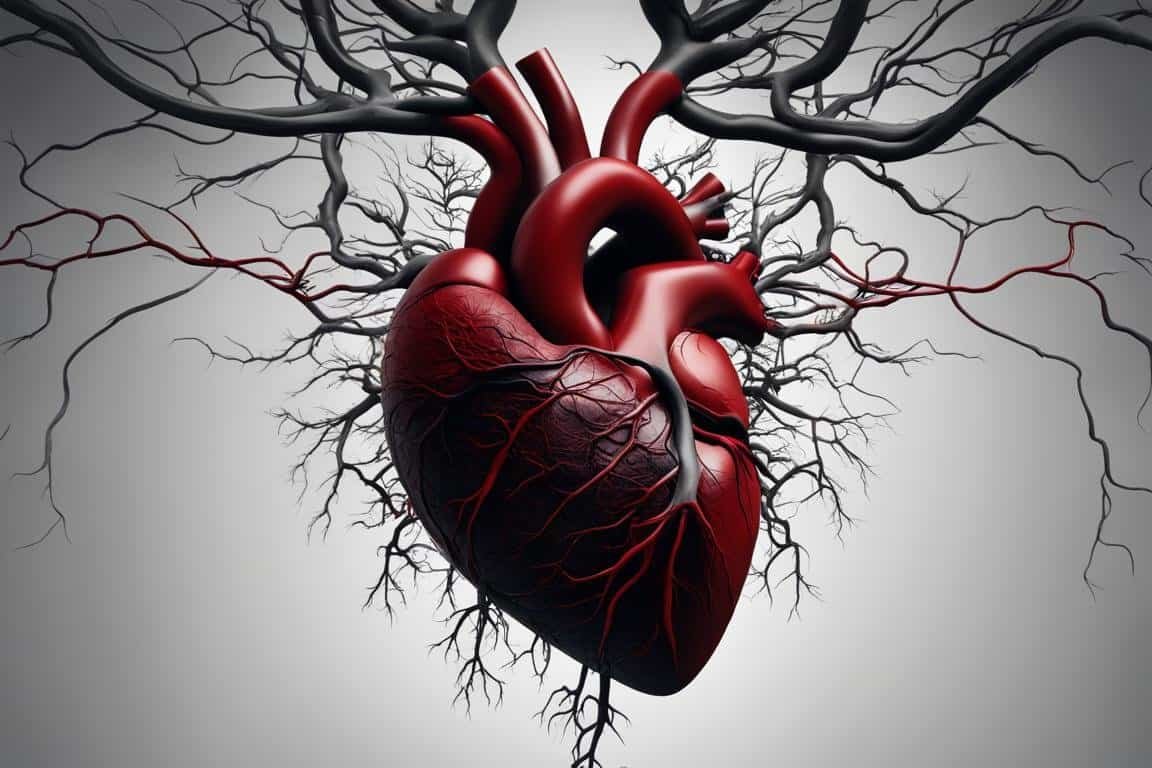A heart attack is a life-threatening medical emergency that occurs when the blood flow to a part of the heart muscle is blocked, usually due to the buildup of plaque in the coronary arteries. This blockage can result in damage or death of the heart muscle.
While a heart attack itself is not classified as a disease, it is often a consequence of underlying conditions like coronary artery disease. Understanding the risks associated with heart attacks is crucial for maintaining heart health and preventing future occurrences.
Heart attacks can be caused by a variety of factors, including age, gender, family history of heart disease, high blood pressure, high cholesterol levels, smoking, obesity, diabetes, and a sedentary lifestyle. The presence of these risk factors can contribute to the development of coronary artery disease, which narrows the arteries and reduces blood flow to the heart muscle.
Recognizing the signs and symptoms of a heart attack is essential for seeking immediate medical attention. Common symptoms include chest pain or discomfort, pain or discomfort in the jaw, neck, back, arm, or shoulder, shortness of breath, fatigue, cold sweat, heartburn or indigestion, lightheadedness or dizziness, and nausea.
Prevention and management of heart attack risks can be achieved through lifestyle changes and medical interventions. Adopting a heart-healthy lifestyle that includes regular exercise, a balanced diet, maintaining a healthy weight, quitting smoking, and managing stress can significantly reduce the risk of heart attacks. Additionally, medication and medical treatments may be recommended by healthcare professionals to control blood pressure, cholesterol levels, and other underlying conditions.
It’s important to prioritize your heart health and be proactive in preventing heart attacks. By understanding the risks, recognizing the symptoms, and taking preventive measures, you can reduce the likelihood of experiencing a heart attack and increase your chances of a healthier life.
Key Takeaways:
- Although a heart attack itself is not a disease, it is a serious medical emergency that can result from underlying conditions like coronary artery disease.
- Risk factors for heart attacks include age, gender, family history, high blood pressure, high cholesterol levels, smoking, obesity, diabetes, and a sedentary lifestyle.
- Recognizing the signs and symptoms of a heart attack is critical for seeking immediate medical attention.
- Prevention and management of heart attack risks can be achieved through lifestyle changes such as regular exercise, a balanced diet, maintaining a healthy weight, quitting smoking, and managing stress.
- Medical interventions, including medication and treatments, may also be recommended to control underlying conditions.
Risk Factors for Heart Attacks
Several risk factors can increase your likelihood of experiencing a heart attack. It’s important to be aware of these risk factors and take steps to manage or reduce them, in order to maintain your heart health. Some of the common risk factors for heart attacks include:
- Age: The risk of heart attacks increases as you get older.
- Gender: Men are generally at a higher risk of heart attacks compared to women.
- Family history of heart disease: If you have a close relative, such as a parent or sibling, who has experienced a heart attack, your own risk may be higher.
- High blood pressure: Hypertension puts additional strain on your heart and increases the risk of heart attacks.
- High cholesterol levels: Elevated levels of cholesterol in the blood can lead to the buildup of plaque in the coronary arteries, increasing the risk of heart attacks.
- Smoking: Tobacco use damages the blood vessels and contributes to the development of heart disease.
- Obesity: Being overweight or obese puts extra stress on the heart, increasing the risk of heart attacks.
- Diabetes: Individuals with diabetes are more prone to developing heart disease, increasing the risk of heart attacks.
- Sedentary lifestyle: Lack of regular physical activity can lead to various health problems, including heart disease.
These risk factors can contribute to the development of coronary artery disease, a condition in which the arteries that supply blood to the heart become narrow or blocked. Reduced blood flow to the heart muscle can result in a heart attack.
It’s important to pay attention to the symptoms of heart disease, as they can indicate an increased risk of heart attacks. Common symptoms include chest pain or discomfort, shortness of breath, fatigue, and heart palpitations. If you experience any of these symptoms, it’s crucial to seek medical attention promptly.

Understanding the risk factors for heart attacks and recognizing the symptoms of heart disease can help you take proactive measures to protect your heart health. In the next section, we will explore ways to prevent and manage these risks to reduce the likelihood of experiencing a heart attack.
Prevention and Management of Heart Attack Risks
Preventing heart attacks and managing the associated risks is crucial for maintaining optimal heart health. By making certain lifestyle changes and seeking appropriate medical interventions, you can significantly reduce your risk of experiencing a heart attack.
1. Adopt a heart-healthy lifestyle:
- Engage in regular exercise, such as brisk walking, cycling, or swimming, for at least 30 minutes most days of the week.
- Eat a balanced diet that is rich in fruits, vegetables, whole grains, lean proteins, and healthy fats, while limiting your intake of processed foods, saturated and trans fats, and added sugars.
- Maintain a healthy weight by following a nutritious diet and engaging in regular physical activity.
- Quit smoking or using tobacco products, as smoking is a major risk factor for heart attacks.
- Manage stress through techniques like deep breathing, meditation, or engaging in activities you enjoy.
2. Medical interventions:
- Consult with your healthcare professional to assess your risk factors and discuss appropriate medication options for controlling conditions such as high blood pressure, high cholesterol levels, and diabetes.
- Follow the prescribed medication regimen diligently and attend regular check-ups to monitor your risk factors and review treatment effectiveness.
- In some cases, medical procedures may be recommended to treat underlying heart conditions and restore proper blood flow to the heart.
By implementing these preventive measures and working closely with your healthcare team, you can actively manage your heart attack risks. Regular check-ups and monitoring of risk factors are essential to ensure the effectiveness of your prevention and management strategies.

Remember, prevention is key when it comes to heart attack risks. Take proactive steps to adopt a heart-healthy lifestyle, seek appropriate medical care, and stay vigilant in monitoring your risk factors. By prioritizing your heart health, you can minimize the likelihood of experiencing a heart attack and lead a fulfilling, heart-healthy life.
Recognizing the Signs and Symptoms of a Heart Attack
It’s crucial to be able to recognize the signs and symptoms of a heart attack, as prompt medical attention can make a significant difference in the outcome. Knowing what to look for and taking immediate action can help minimize heart damage and increase your chances of survival.
Common symptoms of a heart attack include:
- Chest pain or discomfort: This is one of the most common and well-known symptoms of a heart attack. It may feel like a tightness, pressure, squeezing, or heaviness in the chest. The pain or discomfort can also radiate to the jaw, neck, back, arm, or shoulder.
- Shortness of breath: Feeling breathless or having trouble catching your breath, even with minimal exertion, can be a sign of a heart attack.
- Fatigue: Unusual fatigue or exhaustion, especially when accompanied by other symptoms, should not be disregarded.
- Cold sweat: A sudden, unexplained cold sweat, similar to the sensation of being clammy, can be an indicator of a heart attack.
- Heartburn or indigestion: Occasionally, the symptoms of a heart attack can mimic those of heartburn or indigestion. If these symptoms occur alongside other signs, it is important to seek medical attention.
- Lightheadedness or dizziness: Feeling lightheaded, dizzy, or faint can be associated with a heart attack. It is crucial not to ignore these symptoms.
- Nausea: Some individuals may experience nausea or a feeling of being sick to their stomach during a heart attack.
Remember, the presence of one or more of these symptoms does not necessarily confirm a heart attack, and individuals may experience different combinations or variations of symptoms. However, it’s important not to ignore these warning signs. If you or someone nearby experiences these symptoms, call emergency services immediately.
| Symptoms of a Heart Attack | What to Do |
|---|---|
| Chest pain or discomfort | Call emergency services immediately |
| Shortness of breath | Stop any physical activity and seek medical help |
| Fatigue | Rest and contact a healthcare professional |
| Cold sweat | Call emergency services and try to stay calm |
| Heartburn or indigestion | Seek medical attention if symptoms persist or worsen |
| Lightheadedness or dizziness | Sit or lie down and call for help |
| Nausea | Seek medical assistance, especially if accompanied by other symptoms |
Conclusion
While a heart attack itself may not be classified as a disease, it is a significant health event that often arises from underlying conditions like coronary artery disease. Understanding the risk factors, recognizing the symptoms, and taking preventive measures are essential for maintaining heart health and reducing the likelihood of experiencing a heart attack.
By adopting a heart-healthy lifestyle, you can greatly improve your overall heart health. Regular exercise, following a balanced diet, maintaining a healthy weight, quitting smoking, managing stress, and getting regular check-ups are all crucial in preventing heart attacks.
Additionally, it’s important to seek medical care when necessary. Healthcare professionals can provide guidance on managing and controlling risk factors such as high blood pressure and high cholesterol levels. Timely medical interventions, coupled with lifestyle changes, can significantly decrease the risks associated with heart attacks.
Remember, your heart health is in your hands. By taking proactive steps towards prevention and implementing necessary changes in your lifestyle, you can reduce the chances of experiencing a heart attack and live a healthier, happier life.

